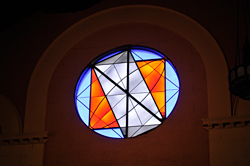A Rose by Any Other Name
 When the college opened Finney Chapel in 1908, it didn’t have the rose window that architect Cass Gilbert wanted to include largely because of an unsettled dispute and no money. It would be more than 65 years before the college completed the chapel’s original design.
When the college opened Finney Chapel in 1908, it didn’t have the rose window that architect Cass Gilbert wanted to include largely because of an unsettled dispute and no money. It would be more than 65 years before the college completed the chapel’s original design.
In 1903, a year after Henry Churchill King began his 25-year tenure as president of Oberlin (1902-27), he desired to have a college chapel than could serve as a common meeting place for academic, religious, and musical occasions.
King approached a few possible benefactors including Frederick Norton Finney, a wealthy western railroader who happened to be the son of Charles Finney, the onetime preacher turned Oberlin College president.
Young Finney liked the idea of a memorial in honor of his father and recommended two planners, one of whom was Cass Gilbert, an up-and-coming architect from Minnesota. Gilbert would design the chapel on the site of Finney’s Oberlin home, at the corner of Professor and Lorain Streets. Finney agreed to finance the entire project.
Gilbert noted that the best building on campus at the time was the Warner Gymnasium with its plain horizontal lines, low-pitched roof and round-arched fenestration, which were to his eyes “serious, quiet, and not extravagant” and that the building aligned with the college’s mood and reputation. He sought to replicate that feel in the new chapel using a Romanesque church style from 12th century France.
The project was not without its problems. Gilbert struggled for many years against interference from Finney and interference from the college about what the chapel should look like, the materials builders should use, and the themes such a multiuse building should evoke.
Despite this tug of wills, Gilbert designed the chapel he wanted—but without one small but essential feature: a rose window. Gilbert and Finney could not come to terms as to who should design the window. Finney withheld the money needed to install the window, a result of his ongoing displeasure with the project.
However, builders completed the chapel in 1908 just in time for Commencement and the college’s 75th anniversary. President King’s solid relationship with Gilbert eventually led to his becoming general architect to the college, a unique position at the time in Oberlin’s history. Apart from Finney Chapel, Gilbert designed three other campus buildings, including the Allen Memorial Art Museum, and one in town.
As for the rose window: Gilbert hoped that over time stained glass, sensitive mural treatment, and commemorative plaques along the inner walls—and a glowing rose window—would soften and warm the chapel’s interior atmosphere.
Many renovations occurred after Finney Chapel was completed and some aspects of the building were changed. However, the plain, translucent leaded-glass window filled the space intended for the rose window.
Finally in 1982, architect William Blunden along with an ad hoc college committee and guided by an old presentation wash drawing from Gilbert’s office, introduced a new color scheme for the interior while renovating the chapel. His efforts produced a closer appearance to Gilbert’s original intentions than it had ever been before. The ad hoc committee invited New York artist Robert Mangold to submit designs for the window. Alumni committed funds for the project, led by Jacob ’42 and Leah Nelson Martin ‘42. Finney Chapel received its rose window in 1992.
Sources: Oberlin Architecture, College & Town: A Guide to its Social History (Kent State University Press, 1985) by Geoffrey Blodgett; Oberlin Alumni Magazine, winter 1992; Architecture of Oberlin College, Oberlin College Archives
Photography by Kevin Reeves